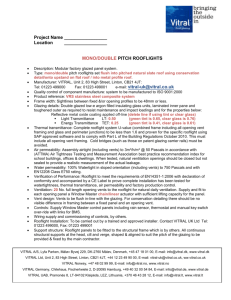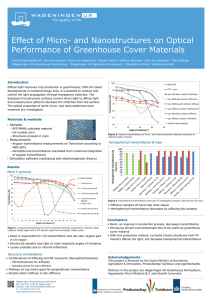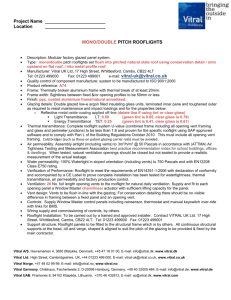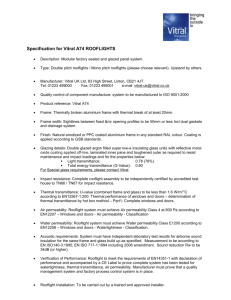80-inf17
advertisement
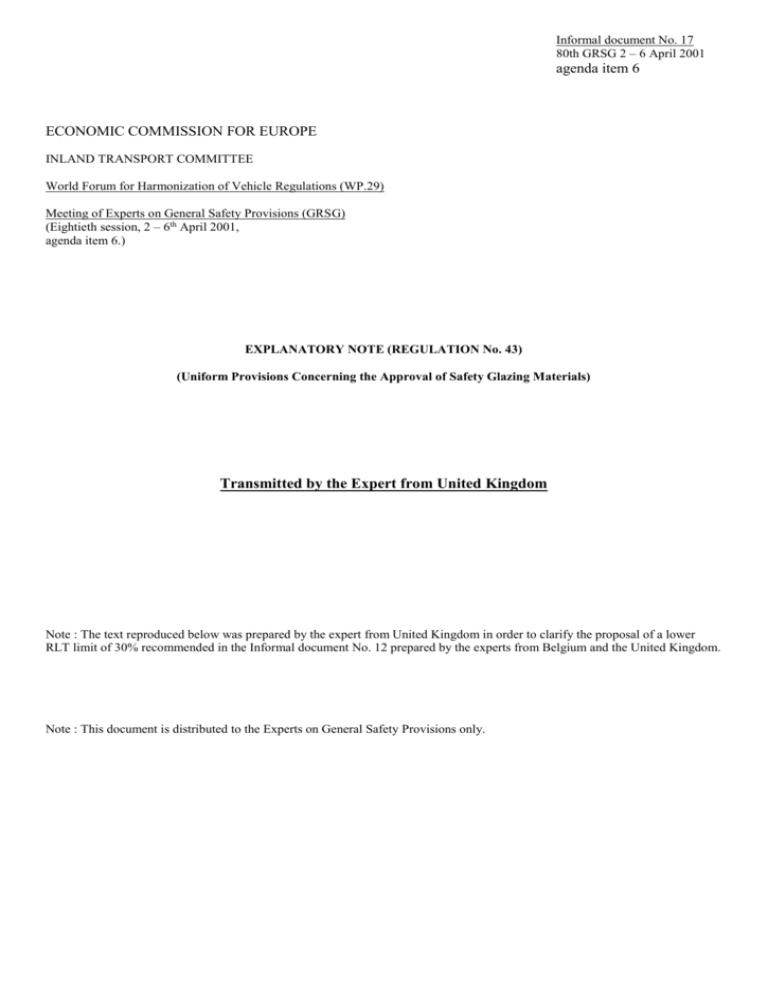
Informal document No. 17 80th GRSG 2 – 6 April 2001 agenda item 6 ECONOMIC COMMISSION FOR EUROPE INLAND TRANSPORT COMMITTEE World Forum for Harmonization of Vehicle Regulations (WP.29) Meeting of Experts on General Safety Provisions (GRSG) (Eightieth session, 2 – 6th April 2001, agenda item 6.) EXPLANATORY NOTE (REGULATION No. 43) (Uniform Provisions Concerning the Approval of Safety Glazing Materials) Transmitted by the Expert from United Kingdom Note : The text reproduced below was prepared by the expert from United Kingdom in order to clarify the proposal of a lower RLT limit of 30% recommended in the Informal document No. 12 prepared by the experts from Belgium and the United Kingdom. Note : This document is distributed to the Experts on General Safety Provisions only. EXPLANATORY NOTE (REGULATION No. 43) (Uniform Provisions Concerning the Approval of Safety Glazing Materials) Note: This document was prepared by the expert from the United Kingdom in view of the need to clarify the lower limit of [30%] regular light transmittance recommended in the Informal document No. 12 prepared by the experts from Belgium and the United Kingdom. It is based on various research papers and aims to cover all of the issues relating to vision, i.e. normal / corrected sighted and elderly drivers whilst assessing the solar and air-conditioning benefits. When, both the UNECE Regulation 43 and Council Directive 92/22/EEC were drafted they laid down requirements that the RLT of windscreens shall not be less than 75%, and, in the case of windows other than windscreens, shall not be less than 70%. However, in the case of windows situated at points which are not essential to the driver’s field of vision (i.e. glazed roof), the RLT of the pane may be less than 70%. Currently, type approval authorities are not united in the manner in which they interpret UN/ECE Regulation 43 and 92/22/EC. Generally, the interpretations of the type approval authorities are, if the indirect Field of View (FoV) requirements can be obtained by both the nearside and the offside external mirrors, then all glazing behind the drivers’ forward vision (180 degrees) can have a light transmittance of 0% - 100%. If the indirect FoV requirements cannot be obtained without the use of the interior mirror(s) then the minimum light transmittance of the rear window/backlite shall be 70%. This was definitely not the intention of the requirements laid down in both documents. Contents 1. Weigt, P., & Albrecht, H,. (1987) Improved solar glazing in the rearward field of view-An approach to update regulations. SAE Technical paper series, No. 872000. 2. Rompe, K., & Engel, G. (1987). The influence of windshields with lower light transmission in driver’s vision during night driving. SAE Technical paper series, No. 870062. 3. Boyd,. P. (1991) Report to congress on tinting of motor vehicle windows. Washington, D.C. U.S Department of Transportation National Highway Traffic Safety Administration. 4. Proffitt, D. R., (Feb 1996) The effect of reduced transmittance window tinting on drivers’ ability to detect targets in their rear-view mirrors Professor of Psychology and of Biomedical Engineering University of Virginia. Bertamini, M., Bhella., M. & Joseph. J. E. Graduate Research Assistants University of Virginia. 5. Freedman, M., Zador, P.L. & Staplin, L.K. (June 1991). Effects of visibility of reduced transmittance film on automobile rear windows. Insurance Institute for Highway Safety 6. UK Research. 1. Improved Solar Control Glazing in the Rearward Field of View – An Approach to Update Regulations. Paul Weigt (Flachglas Aktiengesellschaft W. Germany) Horst Albrecht (Volkswagen W.Germany) Introduction The tendency in modern car styling is to use ever increasing large glass areas. Initially, this does not pose any restraints as enlarged glass areas usually provide better vision. However, with it comes the problem of thermal discomfort. Hence, this leads to the task of improving interior comfort by reducing solar energy radiating into the vehicle and onto the passengers. Glazing for Improved Interior Vehicle Comfort Luminous transmission (LT) in the 1800 forward field of view is well defined and established, however, there is scope to allow a light transmittance less than 70% for other glazing without jeopardising safety and visibility. The main feature of an improved vehicle glazing system that reduces solar radiation penetration, is low energy transmittance. In the indirect FoV which starts approximately behind the ‘B’ pillar the light transmittance can be lowered to about 40% 30% safely. However, the interior rear view mirror should have a reflectance of at least 70%. Properties of Low Heat Transmittant Glazing In looking for a cost effective solution to reduce heat transmittance for toughened side and rear windows, the method of permeation of metal or metal oxide on green toughened glass is used. These heat absorbent coatings should also be hard in order to provide the necessary abrasion resistance without further protection. The colour of these coatings should be grey or brown-grey, because in combination with green glass produce an aesthetically acceptable visual effect. Reaction of Drivers to Dark Glass A fleet of five cars were equipped with heat absorbing dark glazing as follows: Position Luminous Transmittance TL Energy Transmittance TE Windscreen Direct Field of Vision 76.4 75.0 58.0 50.0 Indirect Field of Vision (Behind ‘B’Pillar) 55.0 35.0 Indirect Field of Vision (Backlite) 40.0 25.0 The exterior rear view mirrors had a reflectance of 55% and the interior mirror had a reflectance of 86%, this combination was claimed to be favourable in terms of visibility for the indirect field of view. The reduction in heat energy penetration in daytime and the reduced glare from the headlamps of following vehicles also attracted positive feedback. The tests revealed that under daytime conditions the rearward visibility did not pose visual problems and at night, high contrast levels are caused due to the headlamps of following vehicles. In order to assess in more detail how drivers react to dark glazing, normal sighted and corrected sight (spectacle wearers) test persons were asked to drive in a simulator in which windscreens of different light transmittances were mounted at a rake angle of 350 along a winding road at night. Five windscreens were used with uniform luminous transmissions between 90% and 40%, one of the windscreens with luminous transmission value of 77.4% was artificially aged introducing 1.5% of haze (scattered light). A dazzling light source was introduced to simulate oncoming traffic. The test persons had to react to targets appearing on the left and the right sides, the targets were presented at four contrast levels (Contrast is defined as the difference between target luminance and that of its background divided by the background luminance). The percentage of correct / no responses and the reaction time to the presented targets were recorded. The results showed that a significant difference in the percentage of right answers between the various windscreens could be detected only at the lowest contrast level. At the higher contrast levels all targets were seen even through the windscreen of 40% luminous transmittance. This suggests that use of such glass in backlites can be justified, if images with high contrast levels are observable. The results (% of right answers) also revealed that there is no difference between test persons with or without spectacles at the three higher contrast levels. However, at the lowest contrast level the spectacle wearers’ percentage of correct responses was generally 20% lower when compared to the ‘normal’ sighted test persons. Conclusions To alleviate the problems associated with window tint, the proposal as a recommendation of this research is to regulate the LT in the indirect field of view to between 30% and 40%. Glazing with reasonable LT limits do not impair the driver’s vision at high contrast levels and can help to increase the thermal comfort. High contrast levels can always be expected when looking through the backlite at important objects for safe driving, i.e. under daylight conditions or at night due to the headlamps of following vehicles. 2. The Influence of Windshields with Lower Light Transmission in Driver’s Vision During Night Driving (1987) Klaus Rompe and Gunter Engel (TUV Rheinland e. V. Institute for Traffic Safety Cologne, FRG) This study was carried out using a driving simulator equipped with interchangeable windscreens with light transmittance levels of 89.0, 76.4, 58.0 and 40.0%. Following a 20-minute learning phase, subjects drove the simulator over a projected road for 12 minutes. During this test phase, single square targets appeared for 2 seconds at one of two randomly selected locations along the horizon with an average pause duration of eight seconds. There were a total of 50 targets and each had an opening on one of its four sides of the target. Targets were presented at four different contrast levels. Background luminance simulated twilight driving conditions. Subjects were divided into two groups based on whether they wore spectacles. The subjects’ task was to indicate the location either left/right or up/down of the opening as quickly as possible. The results measured were based on the percentage of correct answers for detection of the target and the associated reaction time. This study also included a condition in which a glare source was present. For the normal-sighted subjects, the percentage of correct answers was near 100% for the three highest contrast targets at all levels of light transmittance. For the lowest contrast targets, the percentage of correct answers was approximately 80% for the 89%, 76% and 58% transmittance windscreens, but dropped to below 60% correct for the 40% transmittance windscreen. The spectacle wearers were unaffected by transmittance level for the three highest contrast targets, however, for the lowest contrast targets, their detection ability declined for both the 58% and 40% windscreens. In fact their detection rates for the 40% windscreen were below 40% in the lowest contrast condition. Target contrast also had an effect on reaction time, but transmittance level did not. The presence of glare showed a similar pattern of results. Normal-sighted subjects were unaffected by transmittance level except at the 40% level where detection rate dropped significantly. Spectacle wearers showed a decline in detection rate at each level of transmittance reduction. There was no evidence that low light transmittance windscreens reduced the influence of disability glare. This study clearly indicates a reduction in low contrast target detection rate at low levels of transmittance for normal-sighted people, and a pervasive and increasing reduction in visual performance for spectacle wearers. 3. Report to Congress on Tinting of Motor Vehicle Windows (1991) Boyd. P (Washington, D.C.; U.S. Department of Transportation National Highway Traffic Safety Administration) Glazing Properties and Solar Load The sun’s energy contains a range of wavelengths comprising the visible light spectrum, shorter ultraviolet wavelengths and longer infrared wavelengths both of which are not visible to humans. Fifty two per cent of the heat is contained in the visible spectrum while the ultraviolet and infrared spectrums contain 2% and 46% respectively. Light striking a window may be transmitted, reflected or absorbed; there are no other possibilities. But glass can be manufactured to filter certain frequencies by reflection or absorption while transmitting other frequencies. Heat Absorbing Glass Heat absorbing (green) glass is manufactured by permeating it with metal or metal oxide. The glass if manufactured to transmit about 70% of the visible light will only transmit about 40% of the solar energy. It is an efficient infrared filter because about 90% of the infrared, but only 30% of the visible light is blocked. However, a drawback of heat absorbing glass is that some 54% of the solar energy is absorbed by the glass. If the vehicle is moving, about 33% of the absorbed energy is re-radiated to the vehicle interior, and if the vehicle is parked, about 50% of the absorbed energy is re-radiated. Standard Tinted Glass Standard tinted glass is designed to reflect solar energy. However, the reflectivity of conventional clear or tinted glass is almost entirely in the visible spectrum and reflectivity is limited in order to avoid creating blinding glare sources for other drivers. Multi-layer Coated Glass Multi-layer coated glass is very efficient in reducing the solar load while maintaining visibility. By reflecting infrared light, which cannot cause glare to oncoming traffic, this type of solar control glass avoids the problem of re-radiating absorbed heat. However, these coatings, although commercially available must be sandwiched between glass because of their delicate nature, therefore the manufacturers consider the technology too expensive for side and rear windows on mass produced volume motor vehicles. Tinting Films Tinting films are usually less efficient than heat absorbing or multi-layer glass because they are less efficient at filtering infrared without dramatically reducing the visible light. It is also likely that its solar load reduction is poorer because the heated film is on the inside of the window, limiting its convection to the outside. Thus, film adhered to glass is much more efficient in providing privacy than in reducing solar heating. Visible Light Clear Glass a)Transmittance 88% Standard Tinting Glass 79% Heat Absorbing Glass 72% Tint Film with Clear Glass 35% Multi-Layer Coated Glass 70% b)Reflectance Total Solar 8% 7% 6% 6% 10% a)Transmittance 77% 59% 41% 48% 41% b)Reflectance 7% 6% 5% 7% 31% c)Absorption 16% 35% 54% 45% 28% d)Solar Load to Moving Vehicle 84% 71% 58% 62% 50% e)Solar Load to Parked Vehicle 85% 77% 68% 71% 55% Air Conditioning The solar load attributable to glazing may reach as high as 70% for a parked vehicle and the air conditioning system is designed to cool a parked vehicle in a reasonable time. This equates to about a 25% load on a non-recirculating system and about 50% on a re-circulating system. Windows covered with a tinting film would decrease the system load between 3% and 7% at the cost of night vision. Heat absorbing glass would reduce it to 5% to 9%, and multi-layer coated glass would make an 8% to 15% reduction without a visibility penalty. Since only a small portion of fuel consumption and hence emissions of a vehicle is the result of air conditioning the benefit even with multi-layer coated glass is very small. Traffic Safety Issues Night driving vision is the fundamental safety issue regarding light transmittance of windows. The visual detection of an object depends on its brightness contrast with the background. The contrast sensitivity of the human eye depends on overall brightness of the scene. In daylight, a low contrast target on a dark road surface can be seen, but at dusk, it can not be seen because the contrast sensitivity of the eye at dusk/twilight is insufficient to detect a target of its contrast. The ageing process causes a similar reduction in the contrast sensitivity of the human eye. Visual contrast sensitivity declines by a factor of 2 about every 20 years after the age of 30. Dusk and night vision become more difficult, and many elderly persons stop driving at night because they lose confidence in their ability to see well enough. A sixty year old person viewing through deeply tinted windows, would experience the effective visual acuity associated with persons in there eighties in many night driving situations. Most accidents are the result of some degree of negligence or inattention, and a reduction of visibility would raise the chance of careless driving even if a very attentive driver could still perceive threat. Accidents at intersections or during manoeuvring exercises can be affected by side and rear window visibility. Intersections at certain acute angles require drivers to use direct rear side vision. Unlit vehicles at dusk and in adverse weather conditions are the most numerous low contrast targets in danger. Bicycles and pedestrians would be harder to detect at night even if they were relatively close. Lane manoeuvres require direct peripheral view, indirect side and rear views through mirrors and direct rear side vision. The driver’s eyes would be adjusted to the light level passing through a windscreen with 75% - 70% light transmittance and they may not adjust quickly enough in side/rear glances for lane change manoeuvres. Reversing accidents are usually serious because the victim is a pedestrian, and many are not reported to ‘Highway Safety Data’ because they occur on private property. Over the past several years, in the U.S. there have been about 90 traffic fatalities in reversing accidents annually. Vans and trucks, which have poorer rear visibility than cars, were involved in 58% of these fatalities, whilst they represent 23% of the vehicle parc. A study of fatal collisions with young children as pedestrians in Washington State reported that 58% were the result of non-traffic accidents, and a van or light truck was involved in 76% of non-traffic fatalities. These reports do not distinguish between night and day accidents nor did they identify vans and trucks or dark glazing fitted, but the inference suggests that visibility is an important factor in serious reversing accidents because vehicles with poorer visibility were vastly over-represented. The Centre High Mounted Stop Light (CHMSL) was required in NHTSA regulations to take advantage of the fact that drivers look though cars ahead in preparing to brake. Dark rear windows in vehicles create unnecessary impediments to defensive driving and reduce the value of CHMSL’s because the CHMSLs of vehicles two or three places ahead can no longer be seen. Interior CHMSL’s would also be dimmed by a dark rear window. A wise policy on window transmittance would permit the greatest freedom to manufacturers seeking solar control that can be justified by current research, but would prevent the reduction in safety that could occur with decreased light transmittance. While it is not possible to quantify the safety effects of lowering the light transmittance through window tinting, data indicate that extensive tinting can reduce the ability of drivers to detect low contrast objects, which could lead to an increase in accidents. The benefits of tinting do not appear great enough to justify any loss in safety that may be associated with allowing excessive tinting of windows. Further, technology already being applied in production car glazing can reduce the solar energy radiating into the passenger compartment and onto the occupants whilst preserving the driver’s visibility. A significant reduction of the drivers visibility would be expected to decrease road safety. 4. Effect of Reduced Transmittance Window Tinting on Drivers’ Ability to Detect Targets in their Rear View Mirrors Dennis R. Proffitt (Professor of Psychology and of Biomedical Engineering University of Virginia 1996), Marco Bertamini, Mukul Bhalla and Jane Joseph (Graduate Research Assistants University of Virginia 1996) This study addressed the degree to which motor vehicle window tint films impede drivers’ ability to detect targets in their vehicle’s rear view mirrors (nearside, offside and interior). Twenty-four subjects participated. Each sat in the driver’s seat of one of four experimental vehicles and attempted to detect a stationary pedestrian in one of the three rear view mirrors within a 2 second time frame. Errors in detecting targets and the distances at which detection occurred were recorded. One experimental vehicle had no after market window tinting, and three were tinted as per table below: Table. Tinting Specifications for the Four Test Vehicles Actual Transmittance b Front Side Rear Side a Target Transmittance Front Side Rear and Rear Side a a 88 88 1 a 50 50 53 53 2 a 50 35 53 38 3 a 35 20 40 13 Vehicle Windscreen 0 Note: The values in the table are percent transmittance for each window a This information was not available from the manufacturer b Rear window transmittance could not be measured with a 1-piece tintmeter. The study was conducted at dusk when targets are near the threshold for detection in an empty unmarked car-park. It was a rectangular area with foliage and trees on one side and a building on the other; it was illuminated by three street lamps situated along two of its four sides. In general, this study found that increased levels of window tinting were associated with an increase in the number of failures to detect a pedestrian in rear view mirrors and with a decrease in the distance needed to detect this target. In addition, increased levels of window tinting were associated with an increase in between-subject variability, meaning that window tinting interfered with target detection more for some subjects than for others. Five of the 24 subjects had perfect performance at the maximum 61metre distance, and thus, their performance could not reflect on the influence of tinting. For the remaining subjects, increased levels of window tinting were associated with poorer performance and higher variability. The increase in variability is especially interesting and indicative of the influence of window tinting on target detection. For the un-tinted vehicle, there was only one failure to detect the target at a distance of 38 metres or less, whereas for the darkest tinted vehicle there were 20 detection failures. Finally, this experimental situation was not representative of all aspects of driving. Most importantly, the subjects in this experiment performed only one task i.e. target detection. In reality, drivers must divide their attention between visual navigation and maintaining an awareness of traffic approaching form the rear. This experimental situation probably exaggerated the distance at which targets would be detected. Whether divided attention would result in poorer performance with increased levels of tinting cannot be ascertained form this study. 5. Effects on Visibility of Reduced Transmittance Film on Automobile Rear Windows (Freedman, M., Zador, P.L. & Staplin, L.K June 1991). This study investigated the effect of window tinting on detecting objects while reversing a vehicle. Four levels of window tinting were applied to the rear side and rear windows of a laboratory vehicle cab: 69%, 53%, 36% and 22%. Three 1.8x 2.7 metre projection screens were placed behind the vehicle onto which natural scenes were projected at a size appropriate for the viewing distance. One of five targets was present on some of the trials. The targets were a vehicle, cyclist, pedestrian, child and road debris. These targets differed in their size and contrast levels. The subject was given 10 seconds on each trial to determine whether one of the targets was present. Subjects ranged from 18 to 90 years of age. The vehicle was always detected. The probability of detection for the child and road debris targets decreased with reduced transmittance values. Probability of detection also decreased with the subjects age. The authors of this study concluded that the study may have understated the magnitude of the visibility deficits that are caused by high levels of window tinting because the subjects were not actually driving the vehicle, and thus, had no distractions during the full 10 seconds that they had to respond. In summary, it can be concluded that a reduction in transmittance reduces the ability to detect targets that would be difficult to see through a clear window. There is no evidence that this reduced visibility is of any consequence to driver performance during well-illuminated daytime conditions, when essentially all important targets are considerably above threshold for detection. Reduced transmittance can be a liability when ambient illumination is low. Visual acuity and contrast sensitivity decrease with the dark adaptation levels that are required to see at twilight and night-time. As the sun sets, the number of important targets that difficult to see increases. Reduced transmittance makes such targets more difficult or impossible to detect. 6. UK RESEARCH The research which the UK has commissioned on Quality and Field of Vision (A Review of the Drivers and Riders needs) is well advanced and the laboratory tests are complete, but, unfortunately the ‘Real World’ trials are not. Therefore, I will be unable to make any comment on results or recommendations, Hopefully, it will be completed for reporting by GRSG81in October 2001.
